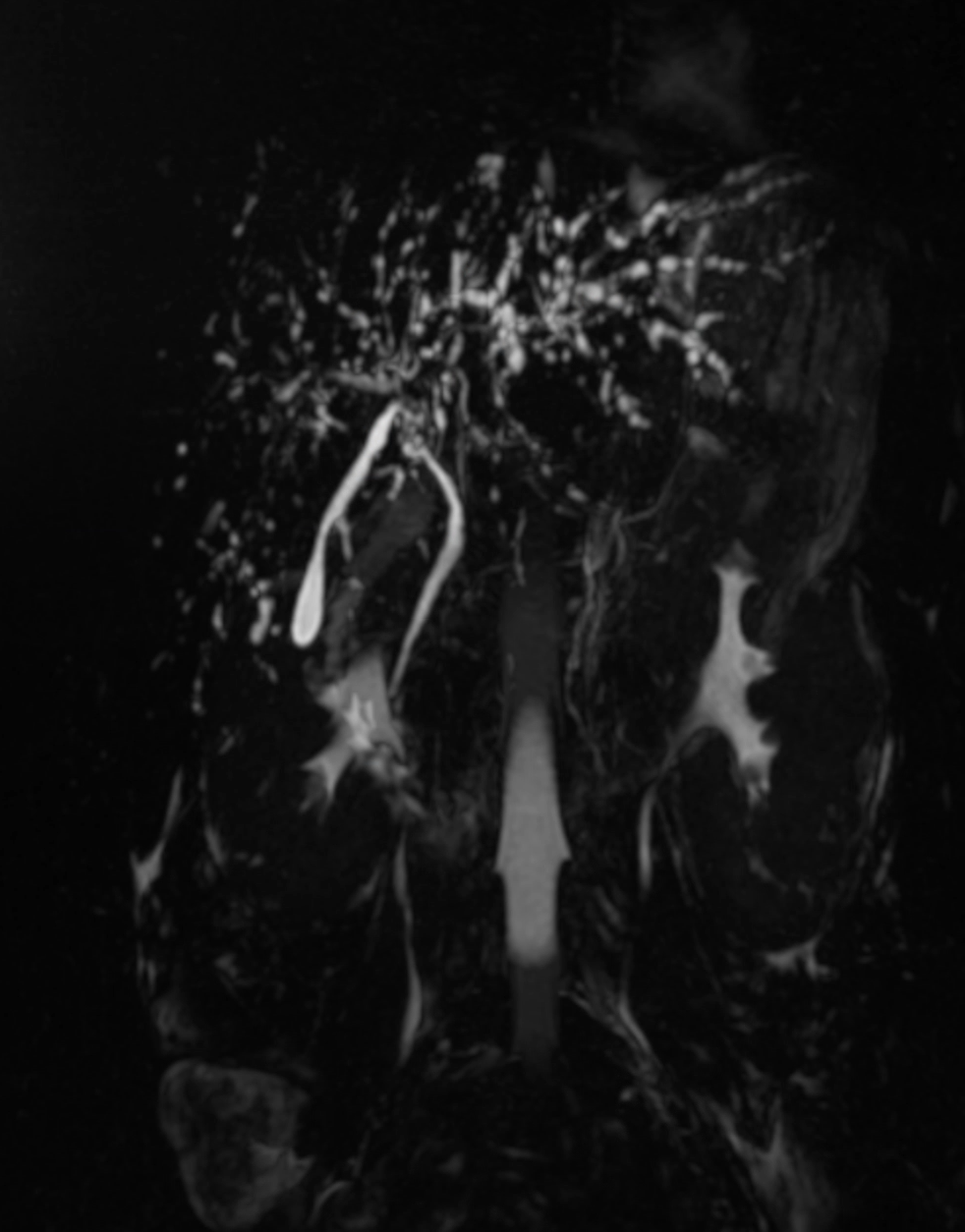Monday Poster Session
Category: Liver
P3899 - Secondary Sclerosing Cholangitis in Critically Ill Patients (SSC-CIP): A Rare Form of Cholestatic Injury With Poor Prognosis
Monday, October 27, 2025
10:30 AM - 4:00 PM PDT
Location: Exhibit Hall

Mark C. Wang, MD (he/him/his)
Keck School of Medicine of the University of Southern California
Los Angeles, CA
Presenting Author(s)
Mark C. Wang, MD, Brycen Ulrich, MD, Andrew J. Cruz, MD, Saroja Bangaru, MD
Keck School of Medicine of the University of Southern California, Los Angeles, CA
Introduction: Secondary Sclerosing Cholangitis in Critically Ill Patients (SSC-CIP) is a form of ischemic cholangiopathy seen in protracted critical illness and associated with a poor prognosis. It is rare, underrecognized, and can mimic more common biliary pathologies, making its diagnosis a challenge. In this case report, we describe a patient with prolonged multiorgan failure who developed SSC-CIP.
Case Description/
Methods: A 30-year-old female with history of systemic lupus erythematosus on immunosuppression presented with respiratory failure requiring intubation. The patient was found to be in ARDS and renal failure, requiring ECMO and CRRT. She developed rising transaminases in the setting of shock which improved but then plateaued with persistent cholestasis. Despite overall clinical improvement, she developed vancomycin-resistant enterococcus bacteremia. A CT scan was obtained, revealing scattered areas of intrahepatic bile duct dilation and small hepatic hypodensities. Subsequent MRCP found bead-like outpouchings in the peripheral branches of the intrahepatic ducts, favored to represent micro-abscesses. There was consideration of endoscopic or percutaneous drainage of the suspected biliary abscesses. Ultimately, discussion between advanced endoscopy, radiology, and hepatology services led to a repeat MRCP revealing diffuse intrahepatic multifocal strictures and dilatation with sparing of the common bile duct, which was consistent with cholangiopathy and most suspicious for SSC-CIP. Therefore, no intervention was pursued, and she cleared her bacteremia with antibiotics. The patient developed cachexia with functional decline but could eventually be discharged with family support. Unfortunately, she was readmitted 3 months later with septic shock of likely biliary origin. She underwent ERCP revealing multiple biliary casts, consistent with SSC-CIP. Tragically, the patient developed multiorgan failure and passed away.
Discussion: Here, we describe a patient who developed SSC-CIP following multisystem critical illness, highlighting an underrecognized entity and its poor prognosis. In this case, achieving the diagnosis was challenging and required multiple MRCPs and multidisciplinary discussions. ERCP can be utilized to remove biliary casts, but there is no cure besides liver transplantation. While SSC-CIP patients have positive transplant outcomes, sequelae of prolonged critical illness can pose barriers to their candidacy. Nevertheless, it is critical that SSC-CIP patients be referred for transplant.

Figure: Figure 1: MRCP 3D Reconstruction Demonstrating Diffuse Intrahepatic Multifocal Strictures with Sparing of the Common Bile Duct
Disclosures:
Mark Wang indicated no relevant financial relationships.
Brycen Ulrich indicated no relevant financial relationships.
Andrew Cruz indicated no relevant financial relationships.
Saroja Bangaru indicated no relevant financial relationships.
Mark C. Wang, MD, Brycen Ulrich, MD, Andrew J. Cruz, MD, Saroja Bangaru, MD. P3899 - Secondary Sclerosing Cholangitis in Critically Ill Patients (SSC-CIP): A Rare Form of Cholestatic Injury With Poor Prognosis, ACG 2025 Annual Scientific Meeting Abstracts. Phoenix, AZ: American College of Gastroenterology.
Keck School of Medicine of the University of Southern California, Los Angeles, CA
Introduction: Secondary Sclerosing Cholangitis in Critically Ill Patients (SSC-CIP) is a form of ischemic cholangiopathy seen in protracted critical illness and associated with a poor prognosis. It is rare, underrecognized, and can mimic more common biliary pathologies, making its diagnosis a challenge. In this case report, we describe a patient with prolonged multiorgan failure who developed SSC-CIP.
Case Description/
Methods: A 30-year-old female with history of systemic lupus erythematosus on immunosuppression presented with respiratory failure requiring intubation. The patient was found to be in ARDS and renal failure, requiring ECMO and CRRT. She developed rising transaminases in the setting of shock which improved but then plateaued with persistent cholestasis. Despite overall clinical improvement, she developed vancomycin-resistant enterococcus bacteremia. A CT scan was obtained, revealing scattered areas of intrahepatic bile duct dilation and small hepatic hypodensities. Subsequent MRCP found bead-like outpouchings in the peripheral branches of the intrahepatic ducts, favored to represent micro-abscesses. There was consideration of endoscopic or percutaneous drainage of the suspected biliary abscesses. Ultimately, discussion between advanced endoscopy, radiology, and hepatology services led to a repeat MRCP revealing diffuse intrahepatic multifocal strictures and dilatation with sparing of the common bile duct, which was consistent with cholangiopathy and most suspicious for SSC-CIP. Therefore, no intervention was pursued, and she cleared her bacteremia with antibiotics. The patient developed cachexia with functional decline but could eventually be discharged with family support. Unfortunately, she was readmitted 3 months later with septic shock of likely biliary origin. She underwent ERCP revealing multiple biliary casts, consistent with SSC-CIP. Tragically, the patient developed multiorgan failure and passed away.
Discussion: Here, we describe a patient who developed SSC-CIP following multisystem critical illness, highlighting an underrecognized entity and its poor prognosis. In this case, achieving the diagnosis was challenging and required multiple MRCPs and multidisciplinary discussions. ERCP can be utilized to remove biliary casts, but there is no cure besides liver transplantation. While SSC-CIP patients have positive transplant outcomes, sequelae of prolonged critical illness can pose barriers to their candidacy. Nevertheless, it is critical that SSC-CIP patients be referred for transplant.

Figure: Figure 1: MRCP 3D Reconstruction Demonstrating Diffuse Intrahepatic Multifocal Strictures with Sparing of the Common Bile Duct
Disclosures:
Mark Wang indicated no relevant financial relationships.
Brycen Ulrich indicated no relevant financial relationships.
Andrew Cruz indicated no relevant financial relationships.
Saroja Bangaru indicated no relevant financial relationships.
Mark C. Wang, MD, Brycen Ulrich, MD, Andrew J. Cruz, MD, Saroja Bangaru, MD. P3899 - Secondary Sclerosing Cholangitis in Critically Ill Patients (SSC-CIP): A Rare Form of Cholestatic Injury With Poor Prognosis, ACG 2025 Annual Scientific Meeting Abstracts. Phoenix, AZ: American College of Gastroenterology.
